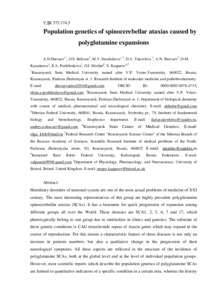Показать сокращенную информацию
Population genetics of spinoсerebellar ataxias caused by polyglutamine expansions
| Автор | Shuvaev, A. N. | |
| Автор | Belozor, O. S. | |
| Автор | Smolnikova, M. V. | |
| Автор | Yakovleva, D. A. | |
| Автор | Andr.N. Shuvaev | |
| Автор | Kazantseva, O. M. | |
| Автор | Pozhilenkova, E. A. | |
| Автор | Mozhei, O. I. | |
| Автор | Kasparov, S. | |
| Дата внесения | 2020-01-20T07:53:56Z | |
| Дата, когда ресурс стал доступен | 2020-01-20T07:53:56Z | |
| Дата публикации | 2019-04 | |
| Библиографическое описание | Shuvaev, A. N. Population genetics of spinoсerebellar ataxias caused by polyglutamine expansions [Текст] / A. N. Shuvaev, O. S. Belozor, M. V. Smolnikova, D. A. Yakovleva, Andr.N. Shuvaev, O. M. Kazantseva, E. A. Pozhilenkova, O. I. Mozhei, S. Kasparov // Vavilovskii Zhurnal Genetiki i Selektsii. — 2019. — Т. 23 (№ 4). — С. 473-481 | |
| ISSN | 25000462 | |
| URI (для ссылок/цитирований) | https://vavilov.elpub.ru/jour/article/view/2142 | |
| URI (для ссылок/цитирований) | https://elib.sfu-kras.ru/handle/2311/129009 | |
| Аннотация | Hereditary disorders of the neuronal system are some of the most important problems of medicine in the XXI century. The most interesting representatives of this group are highly prevalent polyglutamine spinocerebellar ataxias (SCAs). It has a basement for quick progression of expansion among different groups all over the World. These diseases are SCA1, 2, 3, 6, 7 and 17, which phenotypically belong to one group due to similarities in clinics and genetics. The substrate of these genetic conditions is CAG trinucleotide repeat of Ataxin genes which may expand in the course of reproduction. For this reason a characteristic feature of these diseases is not only an increase in patient numbers, but also a qualitative change in the progression of their neurological symptoms. All these aspects are reflected in the structure of the incidence of polyglutamine SCAs, both at the global level and at the level of individual population groups. However, most scientific reports that describe the population genetics of polyglutamine SCAs are limited to quantitative indicators of a specific condition in a certain area, while the history of the occurrence and principles of the distribution of polyglutamine SCAs are poorly understood. This prevents long-term predictions of the dynamics of the disease and development of strategies for controlling the spread of mutations in the populations. In this paper we make a detailed analysis of the polyglutamine SCAs population genetics, both in the whole world and specifically in the Russian Federation. We note that for a better analysis it would be necessary to cover a wider range of populations in Africa, Asia and South America, which will be possible with the development of new methods for molecular genetics. Development of new methods of detection of polyglutamine SCAs will allow the scientists to better understand how they lead to the brain disease, the means of their spread in the population and to develop better methods for therapy and prevention of these diseases. | |
| Тема | spinocerebellar ataxia | |
| Тема | polyglutamine diseases | |
| Тема | population genetics | |
| Тема | epidemiology | |
| Название | Population genetics of spinoсerebellar ataxias caused by polyglutamine expansions | |
| Тип | Journal Article | |
| Тип | Journal Article Preprint | |
| Страницы | 473-481 | |
| ГРНТИ | 76.03.39 | |
| Дата обновления | 2020-01-20T07:53:56Z | |
| DOI | 10.18699/VJ19.516 | |
| Институт | Институт фундаментальной биологии и биотехнологии | |
| Подразделение | Базовая кафедра медико-биологических систем и комплексов | |
| Журнал | Vavilovskii Zhurnal Genetiki i Selektsii | |
| Квартиль журнала в Scopus | Q4 | |
| Квартиль журнала в Web of Science | без квартиля |

